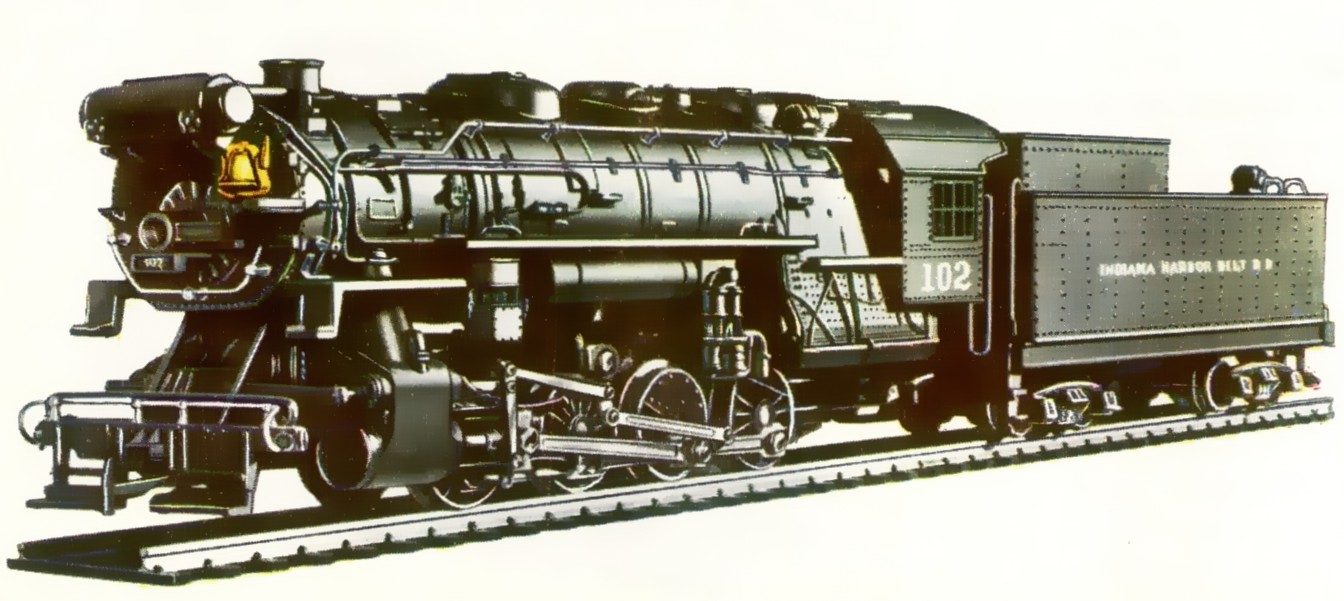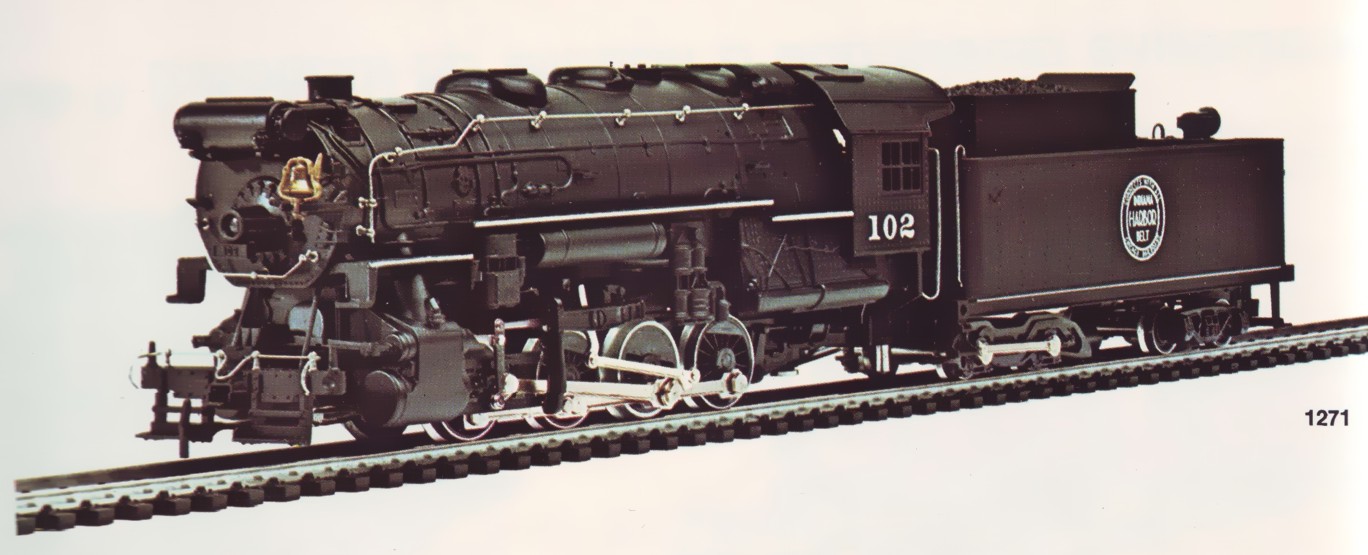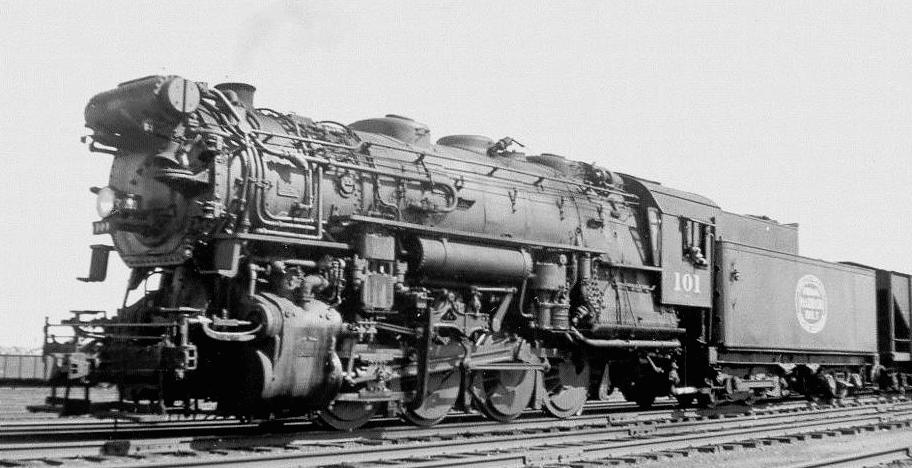

Steam Train class Switcher 0-8-0
The United States Railroad Administration USRA), the Federal organization which ran and supervised the railroad in the US from 1918 till 1921, They standardized all the mostly used locomotives, as to simplify and standardise the production of railroad material, during the period of the war. The majority of these projects were good results, and many were used right up till the end of the steam era in the States.
The most commonly used of the 12 base models was the 0-8-0. In 1927, the American Locomotive Company, and Brooks Works, built a locomotive for shunter work with three cylinders, which derived from original projects USRA only in appearance.
The Locomotive Harbour Belt, a heavy steam loco, used in shunting duties, of the «Indiana Harbor Belt».
Amongst the many types of Locomotives for shunting with wheel arrangement 0-8-0 this was the most powerful. It had three cylinders, two external, and one internal; and a rear bogie with «booster » (the bogie nearest the Loco on the tender, kicked in when starting to move, and would disengage when speed was attained). The Indiana Harbour Belt had three Locos of this type, class S 294, one of which, the 102 used as reference in reproducing this model, was built in 1927 by the American Locomotive Company.
The gearing, with « Walschaert » distribution, is functioning in this model as so in the front headlamp.

From the 1963 catalogue

Length cm. 27.
A real “chef d’ouvre”. In Indiana Harbor Belt livery was one of the best sellers if Rivarossi.
Many small variations have been made over the years, but always high standards of finishing. The main difference, apart from the very first models with motors in the tender, is the version with booster on the front bogie of the tender, as described previously.
Produced by Rivarossi from 1960 until 1977.
In the liveries of: Indiana Harbor Belt, Missouri Pacific, Reading, Santa Fe

Quella riprodotta qua sopra è l'originale 102 IHB da cui è stato desunto il modello di Rivarossi. L'immagine è tratta dal catalogo RR del 1963. Probabilmente la foto è parte della documentazione utilizzata per realizzare il prototipo.
Come citato nell'articolo sotto riportato di Gianni Carrara il carrello anteriore col booster è coperto de una didascalia.
The Steam Locomotive class 0-8-0 of the Indiana Harbor Belt
(by Gianni Carrara)

A symbol of what Rivarossi represented, in determination to achieve standards and variety of products, and at the same time introduce newer ideas into the railway model market. Which other company would have decided to enter with a prototype the mass market of modelling, especially the American market. A locomotive produced in real life in only three examples for a nearly unknown railway company? One of the most significant locomotives of the history of Rivarossi, born at the beginning of thermoplastic injection moulding, adapt to satisfy the most demanding modeller of that time, being as realistic as possible, and at a competitive price. Remaining on the Rivarossi catalogue right up till the end of production at Rivarossi.
Notes on the prototype.
The Railroad company Indiana Harbour Belt is founded in 1907 from the incorporation of other minor companies, which served the area surrounding the city of Chicago, arriving till today, through a long story of incorporations, mainly with the guidance of the New York Central. The activity of the IBH and the transfer of the goods trains between the various stations of the bigger companies operating in the area around Chicago and in the ports on lake Michigan.
This type of duties required locomotives with a high capacity of haulage, thus traction was a very important detail, speed on the other hand was not such a big deal. During the steam age the best example of the ideal Loco for this job, would be the three locomotives class U-4a built in 1927 by Brooks for the IHB. These locomotives, numbered from 100 to 102, were equipped (not a common feature in the US) with three cylinder and one auxiliary engine (booster) on the first bogie of the tender. This demanded a high production rate of steam, obtained thanks to a boiler of increased dimensions, which gave these Locomotives quite an imposing aspect. Known also as “super 0-8-0” these locomotives remained in service until 1951.
The Rivarossi production run.
Considering the date of birth of the actual model, well detailed, and with many details present on the mould, additional details to be added later. In fact some of the details, like the suspension and leverage of the central cylinder are only fully appreciated when dismantling the model. Rivarossi produced four versions of this locomotive, depending on the motorization used: with motor in the tender, motor on ball bearings, or on bronze bearings in the cabin. The illumination was limited to the only front headlamp (without lens), whilst the one on the tender was non working. Pick up of power, was via right wheels for one polarity, and the left for the other; a sprung pick up on the coupling between the tender and the loco, guaranteed the transmission of the polarity to the motor, therefore this loco could only circulate on track with its tender hooked up. The most evident characteristic of the prototype was the presence of the booster on the two axles of the front bogie of the tender, a unique detail in the world steam locomotion, and quite a pleasure to the eye in seeing in movement. Unfortunately for quite a few years Rivarossi neglected this detail, to the point, that when he decided top put a photo of the prototype in his catalogue, he covered the area of this bogie, as not to show this detail, as on the model the bogie was not correct. When production of this locomotive was also decided to do in O scale, this detail could not be hidden any more, so finally the locomotive was given the correct bogie, also in Ho scale. Two version were produced with wording on the locomotive, and on the tender: the elder had on the tender the name of the company along its side, whilst the more recent had the logo of the company. Since both the lettering were on the real loco, the Rivarossi versions were referred to the prototype. The transmission was via, (Rivarossi style) a single axle, with worm screw and geared; the powered wheel was the third and had a rubber adherence ring added on the left wheel. The main defect of this locomotive was with the wheels, as the prototype had wheels with the diameter of 57”, those on the model, in scale were around 51”, this solution was probably determined because of the exaggerated, but for that period normal dimension of the flange. In any case, even though today it does show its age, this remains a very significant locomotive for a collector and can still show its beauty on a rail layout.